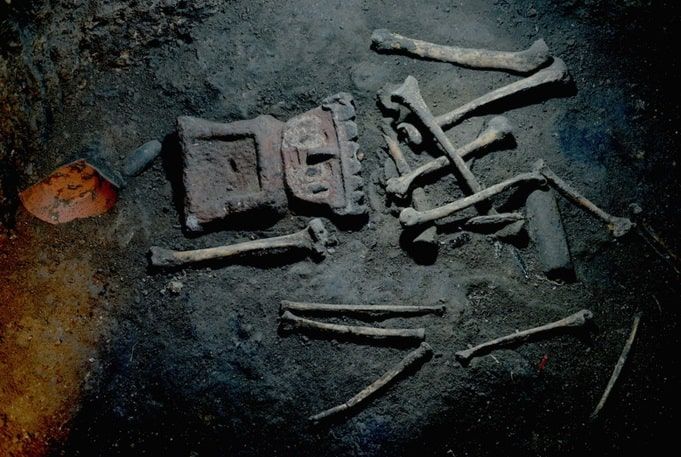The destruction of Zultépec-Tecoaque 500 years ago, by Hernán Cortés' revenge
The order to devastate the place was given after the capture of a Spanish caravan, whose members were sacrificed on different dates of the ritual calendar.

In Izcalli, the culminating month of the Mesoamerican calendar, the Acolhua town of Zultépec, ally of the Triple Alliance, celebrated for the last time the rituals in honor to the old god, Xiuhtecuhtli; in that lapse, corresponding to part of January and February of 1521, its settlers already knew that the revenge for the capture that they had made of a Spanish caravan, part of the expedition of Pánfilo de Narváez in its assignment to apprehend Hernán Cortés was approaching.
It is probable that in those dates were sacrificed the last captives of 450 -among men, women, and European children, Tainos from the Antilles, Tlaxcaltecs, Totonacos, Mayas, mestizos, mulattos, and zambos- who were offered to the pre-Hispanic divinities in the site, throughout eight agonizing months. For this reason, the "Hill of the Quails" began to be named in Nahuatl as Tecoaque, "where they were eaten".
Just as it has found contexts related to this captivity, the multidisciplinary team of the National Institute of Anthropology and History (INAH) that works in that archaeological zone, also has found testimonies of the counterpart of the history that happened five centuries ago, when the major constable Gonzalo de Sandoval devastated this population, by order of Cortés.
The director of the site, Enrique Martínez Vargas, indicates that Zultépec-Tecoaque played a double role in the history: it was a point of resistance to the Spanish advance and of its indigenous allies and, at the same time, of the beginning of the conquest of Mexico-Tenochtitlan, reason why it is particularly significant in this 2021 that commemorates 500 years of the fall of the Tenochtitlan capital.
The reprisal against Zultépec must have taken place at the beginning of March 1521, without being able to specify a date, says the INAH researcher, after mentioning that the event is mentioned in sources such as Historia verdadera de la conquista de la Nueva España, by Bernal Díaz del Castillo, and Tercera Carta de Relación, by Hernán Cortés.
In the latter, the conqueror narrates that he sent Sandoval to bring the 13 brigantines to Tlaxcala to besiege Tenochtitlan, accompanied "with fifteen horses and two hundred laborers", and in passing "to destroy and devastate a large town, subject to this city of Tesuico (Texcoco), that borders with the terms of the province of Tascaltecal (Tlaxcala), because the natives of it had killed me five horses and forty-five laborers that came from the Villa de la Vera Cruz to the city of Temixtitan (Tenochtitlan), when I was surrounded in it, not believing that such a great treason would be done to us [...]".
Among the information that the directors of the research initiative, Enrique Martínez Vargas and Ana María Jarquín Pacheco, have been able to deduce in three decades of systematic work in the archaeological zone, is that the population of Zultépec increased after the capture of the caravan, since people from Tenochtitlan arrived to participate in the sacrifices of the captives and, it is possible, that it had approximately five thousand inhabitants at the time of these events.
Fearing revenge, the place began to fortify itself. The Acolhuas of Zultépec closed access to the residential areas near the main road, building walls and installing stocks around them, to make it difficult for those commanded by Gonzalo de Sandoval to pass, which was insufficient:
"They managed to flee some warriors who remained in the town, but women and children remained, who were the main victims, as we have been able to verify in a stretch of 120 meters of the roadway, with the discovery of a dozen of bones of female individuals, who appeared 'protecting' the remains of ten infants between five and six years of age, whose sex could not be determined. The disposition of the burials suggests that the people were fleeing and were massacred and buried in an improvised manner.
"The women and children who remained sheltered in their chambers were in turn mutilated, as evidenced by the recovery of severed bones on the floor of the rooms. The temples were also set on fire and the sculptures of gods were decapitated; this is how this site, which represented a resistance for Cortés, was destroyed", says the archaeologist.
In his Tercera Carta de Relación, Cortés adds that when Gonzalo de Sandoval passed through there, "certain Spaniards who were with him, in a house of a town that is between Tesuico (Texcoco) and the one where they killed and captured the Christians (Zultépec), found on a white wall written with charcoal these words: 'Here was imprisoned the unfortunate Juan Yuste", who was a nobleman of the five horses, which was certainly something to break the heart of those who saw him".
For Martínez Vargas, some of the most interesting aspects are found in vestiges that indicate the coexistence between the Acolhuas of Zultépec and the prisoners of the caravan who, even, were their guests, as it is demonstrated by the series of modifications that they made to their dwellings to lodge the foreigners. Added walls and the presence of ovens in the European style are some of the elements that indicate this cultural exchange, hence the importance of continuing with the investigation in the living areas.
Knowing the siege of Gonzalo de Sandoval, its inhabitants also hid all possible evidence of these acts in the town's cisterns, of which 22 have been explored to date: bones of sacrificed captives that were modified as trophies; remains of livestock (cows, goats, pigs) and pack animals that accompanied the convoys, sculptures of pre-Hispanic deities and a great variety of personal objects of the prisoners.
More than 25 thousand pieces discovered up to now and the advance of the investigations, which have been concentrated in 3.5 hectares of the 32 that integrate the archaeological site, with time will give just dimension to the scopes of this revenge, which was undertaken in a single day.
Source: INAH




